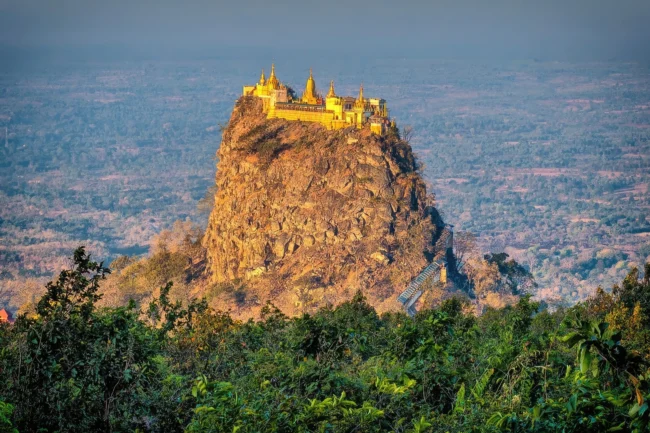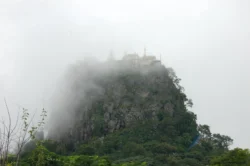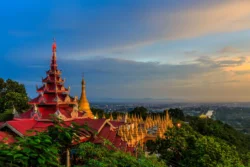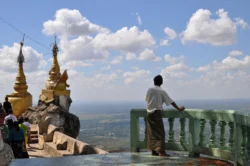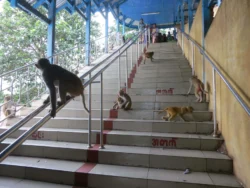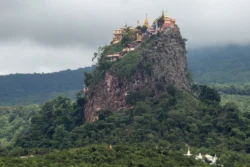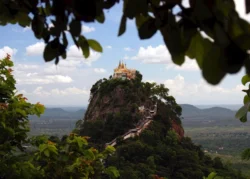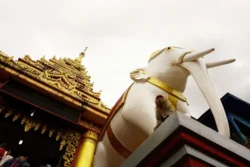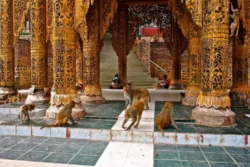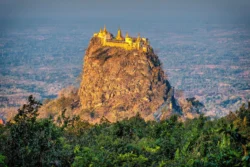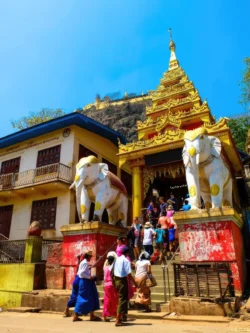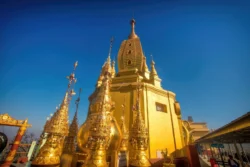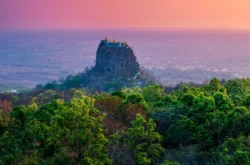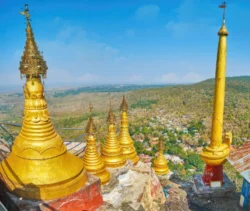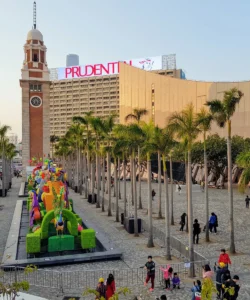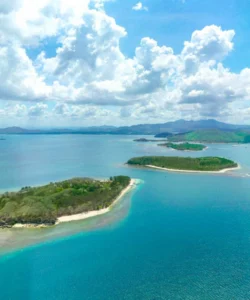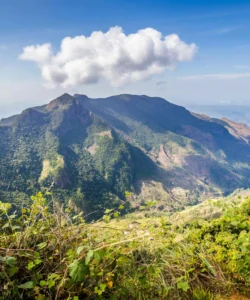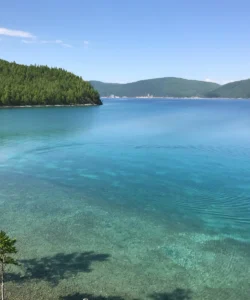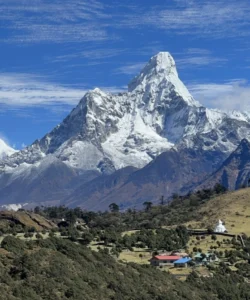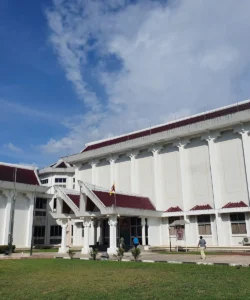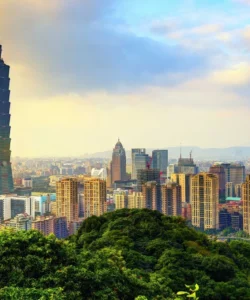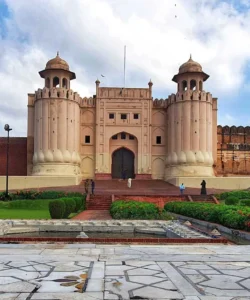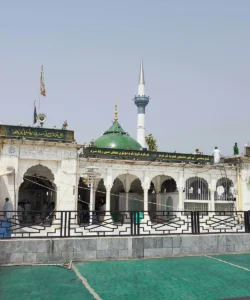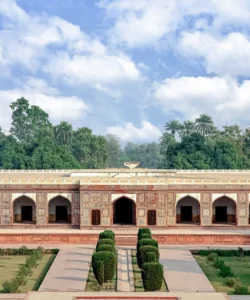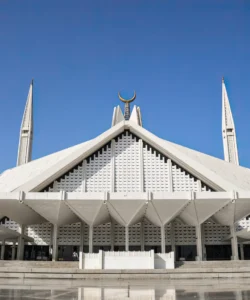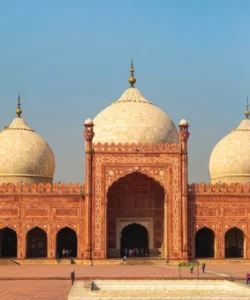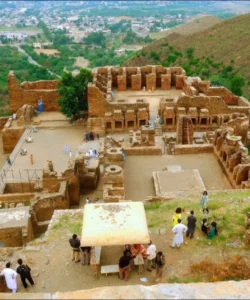Mount Popa is a unique and highly revered natural and spiritual landmark in central Myanmar. It’s not just a mountain, but a powerful symbol of Burmese animist beliefs (Nat worship) intertwined with Buddhism, featuring a spectacularly perched monastery.
Name: Mount Popa (Burmese: ပုပ္ပားတောင်; MLCTS: puppa: taung, meaning “Flower Mountain”). Often, the associated volcanic plug with the monastery is referred to as Popa Taungkalat (meaning “Pedestal Hill”), while the actual main volcano (a larger, more conventional cone) is called Taung Ma-gyi (“Mother Hill”).
Address: Mount Popa is located in central Myanmar’s Mandalay Region, approximately 50 km (31 mi) southeast of Bagan. The primary access point for visitors to Taung Kalat is via the town of Kyaukpadaung, which is around 10 km from the base of the plug.
How to Get There:
Most visitors access Mount Popa as a day trip from Bagan, the famous ancient city.
- By Air: The closest airport for visitors to Bagan and Mount Popa is Nyaung-U Airport (NYU) near Bagan. It has direct flights from major cities like Yangon and Mandalay.
- From Bagan to Mount Popa (Taung Kalat):
- Taxi/Private Car (Recommended): This is the most common and convenient way. The drive takes about 1.5 hours from Bagan. Many hotels and tour operators in Bagan offer day trips to Mount Popa, often combined with a stop at Salay (known for its wooden monastery).
- Scooter/Motorbike: For adventurous and experienced riders, renting a scooter in Bagan is an option, offering flexibility.
- Bus/Shared Van: Buses or shared mini-vans may be available from the Nyaung-U bus terminal.
- Ascending Taung Kalat: Once you reach the base of Taung Kalat, you’ll embark on the iconic ascent:
- 777 Steps: A long, covered stairway of 777 steps leads from the base to the monastery at the summit. The climb is not overly strenuous but does require walking barefoot (as is customary for holy sites in Myanmar).
- Monkeys: The staircase is lined with many macaque monkeys, which are often bold and may try to snatch food or loose items. Be mindful of your belongings.
- Entrance Fee: There is typically a nominal donation requested at the base of Taung Kalat, and additional donations may be expected from cleaners along the stairs.
- Best Time to Visit: The dry season, from October to March, offers the best weather for the climb and clear views. Early mornings are cooler and less crowded.
Landscape and Architecture:
Mount Popa’s “landscape” is a dramatic volcanic creation, contrasting with its arid surroundings, and its “architecture” is a captivating blend of natural geology and human-built sacred structures.
- Dormant Volcano: Mount Popa (Taung Ma-gyi) is a dormant stratovolcano, rising 1,518 meters (4,981 feet) above sea level. It has a large caldera, which contributes to its unique appearance from different directions.
- Volcanic Plug (Taung Kalat): Southwest of the main volcano, and distinct from it, is Taung Kalat (Pedestal Hill). This is a sheer-sided, cylindrical volcanic plug – a remnant of a volcanic vent where magma solidified and the surrounding softer rock eroded away. Taung Kalat rises dramatically 657 meters (2,156 ft) above sea level (and 2,000 feet from the surrounding plain), creating a natural pedestal.
- Oasis in Dry Zone: Despite being located in central Myanmar’s dry zone, the Mount Popa area is notably fertile, fed by over 200 springs and streams. This abundance of water allows for lush greenery, including flowering trees, and makes it an oasis in an otherwise arid region.
- Popa Taungkalat Monastery: Perched precariously on the very summit of Taung Kalat is a cluster of Buddhist monasteries, stupas, and shrines. These structures are typically adorned with gold stupas, white-washed walls, and intricate Burmese architectural details. The climb involves passing through numerous small market stalls and smaller shrines dedicated to Nats.
- Nat Shrines: Throughout the complex, especially along the 777 steps, there are numerous colorful and sometimes flamboyant shrines dedicated to the 37 Great Nats (spirits) of Myanmar’s indigenous animist religion. These shrines house statues of the Nats, often adorned with offerings.
- Stairway Architecture: The covered stairway itself is a significant architectural feature, spiraling up the plug and providing a unique pathway through the various shrines and past the monkeys.
What Makes It Famous:
- Spiritual Home of the Nats: Mount Popa (specifically Taung Kalat) is the most important pilgrimage site for Nat worship in Myanmar. It is considered the abode of the 37 Great Nats, ancient Burmese animist spirits, making it a unique blend of traditional animism and Buddhism.
- Spectacular Monastery on a Volcanic Plug: The sight of the gilded Popa Taungkalat Monastery seemingly defy gravity, perched atop the dramatic, sheer-sided volcanic plug, is incredibly photogenic and a truly unique architectural feat of integration with a natural landform.
- “Myanmar’s Mount Olympus”: Its designation as the home of the Nats has earned it the nickname “Myanmar’s Mount Olympus,” highlighting its central role in Burmese mythology and spiritual beliefs.
- Panoramic Views: From the summit of Taung Kalat, visitors are rewarded with breathtaking panoramic views of the surrounding arid plains, the distant ancient city of Bagan, and the larger cone of Taung Ma-gyi (Mount Popa itself).
- Unique Cultural Experience: The ascent offers a fascinating cultural experience, witnessing pilgrims making offerings to the Nats, observing the symbiotic (and sometimes mischievous) relationship with the resident monkeys, and experiencing a form of faith distinct from mainstream Buddhism.
- Natural Oasis: Its lush greenery and numerous springs in an otherwise dry zone make it a natural oasis and a significant ecological point of interest.
Differences from Some Other Wonders:
- Dual Sacred Site (Nat Worship & Buddhism): Unlike purely Buddhist sites (Shwedagon Pagoda, Borobudur, Bagan) or purely Hindu sites (Prambanan, Meenakshi Amman Temple), Mount Popa uniquely serves as a major pilgrimage site for both Theravada Buddhism and the indigenous Nat animist religion, with shrines for both coexisting side-by-side. This syncretism is a defining cultural differentiator.
- Monastery on a Volcanic Plug: While other temples are on mountains (Uluwatu, Tanah Lot) or within calderas (Mount Bromo, Mount Rinjani), Popa Taungkalat’s monastery is perched atop a very specific geological formation: a sheer-sided volcanic plug, giving it an unparalleled precarious and dramatic appearance. This makes the mount itself an active part of the “architecture.”
- 777 Steps & Monkey Interaction: The specific experience of climbing 777 steps (barefoot) while navigating a large population of sometimes mischievous monkeys is a unique physical and interactive challenge not found at most other religious or natural sites.
- Less Grand Scale of Individual Temple: While the monastery complex on Taung Kalat is impressive in its setting, the individual temple structures themselves are not on the scale of monumental complexes like Angkor Wat or the Shwedagon Pagoda’s central stupa. Its “grandeur” is in the combined effect of its location and spiritual significance.
- Oasis in an Arid Zone: Its unique microclimate and lush vegetation, standing out as an “oasis” in Myanmar’s central dry zone, create a specific ecological characteristic that distinguishes it from more uniformly forested mountains or purely arid landscapes.
- Pilgrimage Focused on Spirits: While many sites are for ancestor worship or deities, the primary focus on appeasing and venerating the 37 Nats (spirits of those who died tragic deaths) gives Mount Popa a specific cultural and folkloric narrative that is quite unique.
Mount Popa Photos:
